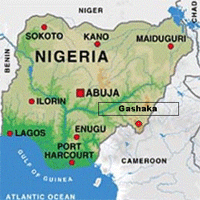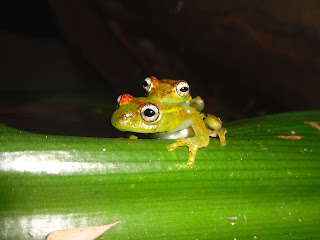“Conservation is a moral issue of beauty, ethics and spiritual value. Without moral values, conservation cannot sustain itself.”
– Dr George Schaller
In my first blog post, I wrote about the fact that a day of free talks that I went to at UCL, was what had inspired me to start writing. These talks were based around the research and conservation being undertaken in the Gashaka Gumti National Park in Nigeria, West Africa, on the boarder with Cameroon.
Gashaka is the largest national park in Nigeria, covering 6,731 sq km of wilderness. It was formed due to the merging of the Gashaka and Gumti Game Reserves. The southern part of the park is located in a mountainous region, covered in thick rain-forest; Whilst woodlands and grasslands dominate the northern end. The variety of different habitats within the park support a uniquely rich community of plants and animals, from ferns to orchids, and chimpanzees to frogs.
The park is also officially labelled as one of Africa's "Important Bird Areas", with over 500 species of bird being found here.
The national park was originally created for a number of reasons, including protection of the local watershed (by protection of the forested slopes that conserve the water resource of the River Benue), the conservation of biodiversity, supporting the traditional livlihoods of the local indigenous people and their rural development and also the protection of their cultural diversity.
Within the national park, is a research station at the village of Gashaka, and a field station in the forests of Kwano. From here, a number of research projects are run, as well as the Gashaka Primate Project, in partnership with University College London and Chester Zoo. More information on the various research projects being undertaken at Gashaka are available at http://www.ucl.ac.uk/gashaka/research/.
I wanted to talk a bit further about two of the speakers; Richard Barnwell (WWF emeritus) and Tasso Leventis (Director of the A.G. Leventis Foundation), who spoke about "Redefining the enclave boundaries" and "Biodiversity conservation in Nigeria: Challenges and opportunities" respectively.
Redefining the enclave boundries:
This subject is interesting, because it shows how the local people can live in harmony with nature, with national parks and special reserves, and that although there may be difficulties along the way, they can often be overcome.
 Enclaves are mountainous areas of land within the boundaries of the national park, free from Tsetse flies, on which the local Fulani people are permitted to graze and farm livestock. It was originally decided that the essential needs of the resident pastoral people and the demands of wildlife conservation could both be accomodated within the same protected area. However, over the decades, the boundries of the enclaves have expanded. The local people have also begun to grow maize - something which they had not done before and which requires a larger amount of land. In order to prevent crop damage by baboons and other animals, hunting has increased, and prickly hedges around the crop fields are used - thus fragmenting the land further. During Richard's latest trip to Gashaka-Gumti, he assisted in the erection of 67 new beacons in order to mark out the re-established boundaries of the enclaves.
Enclaves are mountainous areas of land within the boundaries of the national park, free from Tsetse flies, on which the local Fulani people are permitted to graze and farm livestock. It was originally decided that the essential needs of the resident pastoral people and the demands of wildlife conservation could both be accomodated within the same protected area. However, over the decades, the boundries of the enclaves have expanded. The local people have also begun to grow maize - something which they had not done before and which requires a larger amount of land. In order to prevent crop damage by baboons and other animals, hunting has increased, and prickly hedges around the crop fields are used - thus fragmenting the land further. During Richard's latest trip to Gashaka-Gumti, he assisted in the erection of 67 new beacons in order to mark out the re-established boundaries of the enclaves.
Biodiversity conservation in Nigeria: Challenges and Opportunities
 The A.G. Leventis Foundation, of which Tasso Leventis is the Director, focuses on the consequences of slash-and-burn agriculture. Similar to what I have previously described about the illegal deforestation and burning that occurs in Madagascar, areas which are now within the national park, came under intense disturbance from slash-and-burn agriculture from the 70s onwards. The A. G. Leventis Foundation supports associations involved in carbon storage, biodiversity protection and watershed protection in areas within Gashaka Gumti. They are also involved with the establishment of farm schools which teach conservation and sustainable agriculture, and they believe that the mere presence of researchers in the park encourages conservation by the locals whilst also adding to scientific knowledge.
The A.G. Leventis Foundation, of which Tasso Leventis is the Director, focuses on the consequences of slash-and-burn agriculture. Similar to what I have previously described about the illegal deforestation and burning that occurs in Madagascar, areas which are now within the national park, came under intense disturbance from slash-and-burn agriculture from the 70s onwards. The A. G. Leventis Foundation supports associations involved in carbon storage, biodiversity protection and watershed protection in areas within Gashaka Gumti. They are also involved with the establishment of farm schools which teach conservation and sustainable agriculture, and they believe that the mere presence of researchers in the park encourages conservation by the locals whilst also adding to scientific knowledge.
The focus of this foundation on a specific conservation issue and its related conservation topics, allows efficient and effective conservation to be carried out.
For more information about Gashaka and some of Nigeria's other National Parks visit Gashaka's website:
Redefining the enclave boundries:

This subject is interesting, because it shows how the local people can live in harmony with nature, with national parks and special reserves, and that although there may be difficulties along the way, they can often be overcome.
 Enclaves are mountainous areas of land within the boundaries of the national park, free from Tsetse flies, on which the local Fulani people are permitted to graze and farm livestock. It was originally decided that the essential needs of the resident pastoral people and the demands of wildlife conservation could both be accomodated within the same protected area. However, over the decades, the boundries of the enclaves have expanded. The local people have also begun to grow maize - something which they had not done before and which requires a larger amount of land. In order to prevent crop damage by baboons and other animals, hunting has increased, and prickly hedges around the crop fields are used - thus fragmenting the land further. During Richard's latest trip to Gashaka-Gumti, he assisted in the erection of 67 new beacons in order to mark out the re-established boundaries of the enclaves.
Enclaves are mountainous areas of land within the boundaries of the national park, free from Tsetse flies, on which the local Fulani people are permitted to graze and farm livestock. It was originally decided that the essential needs of the resident pastoral people and the demands of wildlife conservation could both be accomodated within the same protected area. However, over the decades, the boundries of the enclaves have expanded. The local people have also begun to grow maize - something which they had not done before and which requires a larger amount of land. In order to prevent crop damage by baboons and other animals, hunting has increased, and prickly hedges around the crop fields are used - thus fragmenting the land further. During Richard's latest trip to Gashaka-Gumti, he assisted in the erection of 67 new beacons in order to mark out the re-established boundaries of the enclaves. Biodiversity conservation in Nigeria: Challenges and Opportunities
 The A.G. Leventis Foundation, of which Tasso Leventis is the Director, focuses on the consequences of slash-and-burn agriculture. Similar to what I have previously described about the illegal deforestation and burning that occurs in Madagascar, areas which are now within the national park, came under intense disturbance from slash-and-burn agriculture from the 70s onwards. The A. G. Leventis Foundation supports associations involved in carbon storage, biodiversity protection and watershed protection in areas within Gashaka Gumti. They are also involved with the establishment of farm schools which teach conservation and sustainable agriculture, and they believe that the mere presence of researchers in the park encourages conservation by the locals whilst also adding to scientific knowledge.
The A.G. Leventis Foundation, of which Tasso Leventis is the Director, focuses on the consequences of slash-and-burn agriculture. Similar to what I have previously described about the illegal deforestation and burning that occurs in Madagascar, areas which are now within the national park, came under intense disturbance from slash-and-burn agriculture from the 70s onwards. The A. G. Leventis Foundation supports associations involved in carbon storage, biodiversity protection and watershed protection in areas within Gashaka Gumti. They are also involved with the establishment of farm schools which teach conservation and sustainable agriculture, and they believe that the mere presence of researchers in the park encourages conservation by the locals whilst also adding to scientific knowledge.The focus of this foundation on a specific conservation issue and its related conservation topics, allows efficient and effective conservation to be carried out.
For more information about Gashaka and some of Nigeria's other National Parks visit Gashaka's website:






































.jpg)





